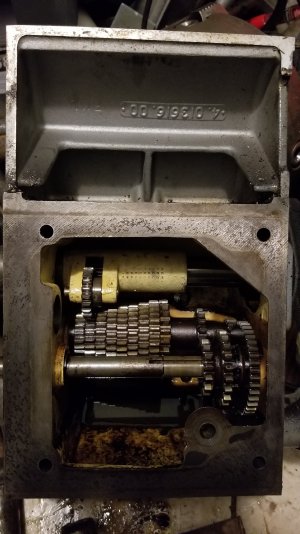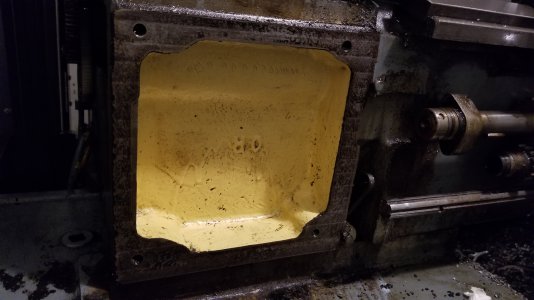My lathe quick change gearbox has an oil leak problem. I saw oil came out of the range selector shaft.
There are 3 rods that need to be disengaged with the box before removing. The top rod is thread dial rod. The 2nd middle rod is the power rod. The bottom rod is reverse/brake/stop/brake/forward lever rod. They make it a rod since there is a second movable lever at the apron.
After draining the oil.
1. I remove the rear end of the top rod. It's a large round nut held by 2 set screws which threads onto the end of the rod. That nut presses on a collar to adjust play and press on a thrust bearing.
On the head/gearbox end of this rod is held on by a bracket that gets bolted by 2 socket cap hex screws. But these 2 screws are tight for access due to the middle rod's gear (which drives the top rod). So next, I need to remove the middle rod.
2. To remove the middle rod, the rear end has a taper pin that needs to be knocked out. Rotate the middle rod by hand (make sure all selectors moved to a location that frees it), and punch it out. There can be a set screw or two there also.
At the gearbox end, there is another taper pin that needs to be punched out. Make sure to hit the smaller end.
3. Unbolt 2 rear bolts holding the bracket that hold all 3 rods onto the lathe.
4. Carefully slide the middle rod back. When doing this, it will give room to slide the "lock" collar of the top rod to give rooms to remove the two socket cap screws on the gearbox end of the top rod. (The lock collar is the one that slides a gear to engage/disengage the top rod to the middle/driver rod).
5. To remove the bottom rod, you can't rotate it 180 degree to knock out the taper pin. The pin has a a thread on top. Just put a nut on it (probably 1/4") and keep turning clockwise, and it will loosen it out.
Now, you can slide all 3 rods out enough to clear the box.
Take out the lathe's gear cover on the left end of the lathe, then remove the quick change gearbox.
All these are memory. There are set screws here and there, pretty obvious.
After I took them apart, there is a layer of thick "mud", probably more than 1/2". The oil is still pretty good. I think due to non-foaming type, so the dirt just settle down.
Now, I have two minor issues. One is why there is no "gasket" between the quick change gearbox and the lathe head? It's just metal on metal. I am surprise it didn't leak there (or did it)?
Second issue is to find an oring for the range selector. I have a viton oring, but it's too thick to come in. Whichever I use, should be hydraulic type. Looks to me around 3/8" diameter. I will measure it carefully before ordering it.
Here are 2 pictures showing the gearbox and the lathe's mating area. You can see no gasket. Should I put a thin bead of RTV on it? That's my plan.


There are 3 rods that need to be disengaged with the box before removing. The top rod is thread dial rod. The 2nd middle rod is the power rod. The bottom rod is reverse/brake/stop/brake/forward lever rod. They make it a rod since there is a second movable lever at the apron.
After draining the oil.
1. I remove the rear end of the top rod. It's a large round nut held by 2 set screws which threads onto the end of the rod. That nut presses on a collar to adjust play and press on a thrust bearing.
On the head/gearbox end of this rod is held on by a bracket that gets bolted by 2 socket cap hex screws. But these 2 screws are tight for access due to the middle rod's gear (which drives the top rod). So next, I need to remove the middle rod.
2. To remove the middle rod, the rear end has a taper pin that needs to be knocked out. Rotate the middle rod by hand (make sure all selectors moved to a location that frees it), and punch it out. There can be a set screw or two there also.
At the gearbox end, there is another taper pin that needs to be punched out. Make sure to hit the smaller end.
3. Unbolt 2 rear bolts holding the bracket that hold all 3 rods onto the lathe.
4. Carefully slide the middle rod back. When doing this, it will give room to slide the "lock" collar of the top rod to give rooms to remove the two socket cap screws on the gearbox end of the top rod. (The lock collar is the one that slides a gear to engage/disengage the top rod to the middle/driver rod).
5. To remove the bottom rod, you can't rotate it 180 degree to knock out the taper pin. The pin has a a thread on top. Just put a nut on it (probably 1/4") and keep turning clockwise, and it will loosen it out.
Now, you can slide all 3 rods out enough to clear the box.
Take out the lathe's gear cover on the left end of the lathe, then remove the quick change gearbox.
All these are memory. There are set screws here and there, pretty obvious.
After I took them apart, there is a layer of thick "mud", probably more than 1/2". The oil is still pretty good. I think due to non-foaming type, so the dirt just settle down.
Now, I have two minor issues. One is why there is no "gasket" between the quick change gearbox and the lathe head? It's just metal on metal. I am surprise it didn't leak there (or did it)?
Second issue is to find an oring for the range selector. I have a viton oring, but it's too thick to come in. Whichever I use, should be hydraulic type. Looks to me around 3/8" diameter. I will measure it carefully before ordering it.
Here are 2 pictures showing the gearbox and the lathe's mating area. You can see no gasket. Should I put a thin bead of RTV on it? That's my plan.


Last edited:

